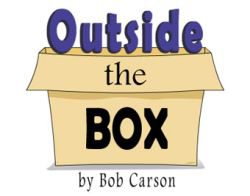Shifting Winds
October 21, 2019,Editor’s Note: The USTA website is pleased to present freelance writer Bob Carson and his popular “Outside the Box” features. This monthly series is a menu of outlandish proposals presented with a wink — but the purpose behind them is serious. The views contained in this column are that of the author alone, and do not necessarily represent the opinions or views of the United States Trotting Association.
“What we need to do is always lean into the future; when the world changes around you and when it changes against you — what used to be a tailwind is now a headwind — you have to lean into that and figure out what to do because complaining isn’t a strategy.” — Jeff Bezos, Amazon
What happens if the revenue from casinos dries up?
What happens if the sports gambling world, after the PAPSA Supreme Court decision, does not have a place for our rather ancient pari-mutuel wager?
What happens if we continue to be a stale product in a world looking for fresh products, a world without much patience, a world where we are a poor wager?
These troubling questions are never far away from all who enjoy races between trotting or pacing horses.
Here are a few more questions:
Will everyone simply wipe away tears and wave goodbye to harness racing because the economics do not work?
Are any “Plan B’s” being considered?
Who will take the helm of our fragile ship?
 Thinking about the future of harness racing is frustrating, heartbreaking and exhausting. Most of us do not have any idea of what is going on behind the scenes. We do not know if any backup plans are available should our existing economic engines fail. The future can be dangerous territory. The only sure bet is that the future will arrive more rapidly than we imagine.
Thinking about the future of harness racing is frustrating, heartbreaking and exhausting. Most of us do not have any idea of what is going on behind the scenes. We do not know if any backup plans are available should our existing economic engines fail. The future can be dangerous territory. The only sure bet is that the future will arrive more rapidly than we imagine.
Most of us believe, or want to believe, there will always be a base of people who enjoy the challenge of owning, raising, selecting, training, and racing harness horses. At some point, we very well could require a completely new framework to make participation in our sport feasible.
This leads to the questions that have plagued our little sport. Who will lead, or more specifically, who has the mandate to lead? Who will have the power or the desire to soldier on in a brave new world of harness racing? Who will make a plan for a world where we are no longer the only legal wager? Let’s be honest, we did not do that well when horse racing had a legal gambling monopoly.
Consider this three-word answer — state breeding farms.
Breeding farms make the product. They realize that if their customers do not have racing opportunities, their product is useless. They realize that dreamers who invest in yearlings for stakes racing are their bread and butter. Many of our brightest stars work on the breeding side of the fence. Maybe we have a young Jeff Bezos in our midst who is thinking five, 10, 20 years from today.
The crossroads ahead may lead to a strange and perhaps unfathomable land. Could you imagine a harness racing future without claiming horses, conditioned horses, or older horses? Is it conceivable that a world with exclusively stakes racing might be the best path? Suggesting such a world may seem blasphemous or idiotic. But, that depends on your point of view.
Racing that does not depend exclusively on wagering is not a new world. Harness horse racing began with a handful of wealthy men like the Rockefellers, Vanderbilts, and Leland Sanford who simply enjoyed competing against each other.
In addition, for some of us, this radical reconfiguration would not be a huge leap. We do not race overnight horses; we play the staking game. For us, the months between 2-year-olds qualifying and the last stakes race are the racing that matters. Our world consists of high highs, low lows, and less grind. Every season when the freshmen qualify is a new season. We have an “off” season in the winter months while horses are in training. Any other horse racing is a world that we rarely visit.
A state program (and the Grand Circuit classification) with heavy or total emphasis on stakes racing will find owners and trainers primarily racing for their own money supplemented by state agricultural programs. Maintaining revenue from gambling would remain a major goal or a hopeful add-on.
The business plan would be simple in this stakes-only world. Should the operators be state breeding farms, they will tell potential buyers how often they will have the opportunity to race and what purses will be available. Passion, marketing, and economics will take over from there.
A state conglomerate of breeding farms could operate efficiently and be innovative. They would have a clear goal to create an environment where their customers can race their products at ages two through four. The better this environment, the more they can expect consumers to pay for their product.
Would breeding farms be more profitable if stakes racing was the only game in their state? Would a re-start improve our sport? Who knows?
A sport run by the breeding associations would have assets, a historical legacy, a foundation of die-hards, a fresh start, freedom to innovate, and agricultural attachments.
Would there be losers in this new era of racing without overnight racing? Of course, there are always losers and winners, and the new structure would probably be uncomfortable for the status quo.
The breeding farms may not want this responsibility, but their alternative could be waking up as cattle farmers in a vegan world.

